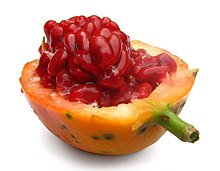
Back Passieblom Afrikaans زهرة الآلام الشائعة Arabic زهرة الآلام الشائعه ARZ Mavi qonaqotu Azerbaijani Синя пасифлора Bulgarian Pasijonka BS Passionera Catalan Passiflora caerulea CEB Blaue Passionsblume German घडीफूल DTY
| Passiflora caerulea | |
|---|---|

| |
| Flower in full bloom together with a wilted flower and a yet unopened bud | |

| |
| Fruit cut and opened | |
| Scientific classification | |
| Kingdom: | Plantae |
| Clade: | Tracheophytes |
| Clade: | Angiosperms |
| Clade: | Eudicots |
| Clade: | Rosids |
| Order: | Malpighiales |
| Family: | Passifloraceae |
| Genus: | Passiflora |
| Species: | P. caerulea
|
| Binomial name | |
| Passiflora caerulea | |
Passiflora caerulea, the blue passionflower,[1] bluecrown passionflower[2] or common passion flower, is a species of flowering plant native to South America. It has been introduced elsewhere. It is a vigorous, deciduous or semi-evergreen tendril vine growing to 10 m (33 ft) or more. Its leaves are palmate, and its fragrant flowers are blue-white with a prominent fringe of coronal filaments in bands of blue, white, yellow, and brown. The ovoid orange fruit, growing to 6 cm (2 in), is edible, but is variously described as having a bland,[3] undesirable,[4] or insipid taste.[5] In South America, the plant is known for its medicinal properties, and is used by both the Toba and the Maka peoples.[4][6]
- ^ BSBI List 2007 (xls). Botanical Society of Britain and Ireland. Archived from the original (xls) on 2015-06-26. Retrieved 2014-10-17.
- ^ USDA, NRCS (n.d.). "Passiflora caerulea". The PLANTS Database (plants.usda.gov). Greensboro, North Carolina: National Plant Data Team. Retrieved 31 January 2016.
- ^ RHS A-Z encyclopedia of garden plants. United c ZKingdom: Dorling Kindersley. 2008. p. 1136. ISBN 978-1405332 965.
- ^ a b Cite error: The named reference
cabiwas invoked but never defined (see the help page). - ^ Cite error: The named reference
tetraphyllin bwas invoked but never defined (see the help page). - ^ Cite error: The named reference
mendiondowas invoked but never defined (see the help page).